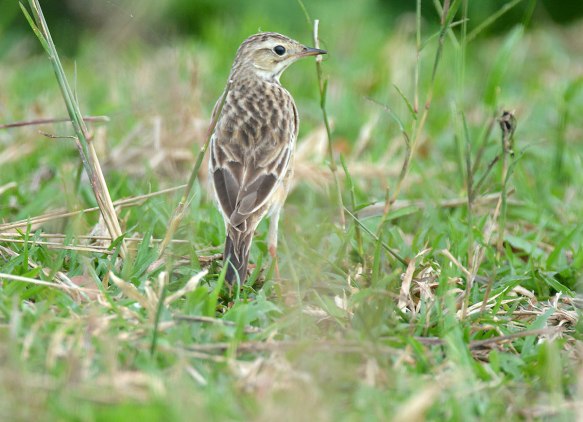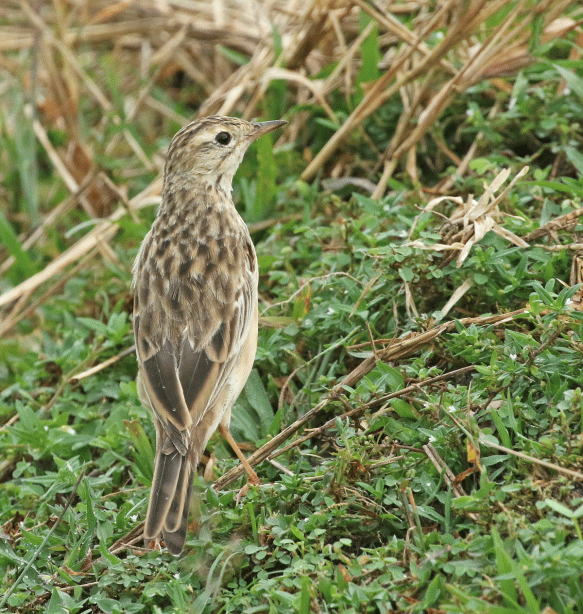The opportunity to observe and photograph a known individual bird over a long period gives a unique opportunity to observe the progression of moult and the effects of feather wear. Examples of such opportunities regionally in recent years have been a first year Siberian Blue Robin in Malaysia (Suara Enggang Vol 20, No 3:3-5) and a similarly aged Firethroat at Nam Khan in northern Thailand.
Now we’ve had the chance to do the same with a Blyth’s Pipit!
Establishing that the bird was in ‘first-winter’ plumage when it was first seen on 2 Jan 2017 (see Part 1), the next moult it was due to undergo was Pre-breeding moult. A quick review from Alström and Mild:
Pre-breeding moult: In the late winter or early spring of the second calendar year, i.e. when the bird is 9–10 months old, most pipits and wagtails go through a partial pre-breeding moult to obtain first-summer plumage. In most pipit species most of the head and body is moulted (a few feathers, particularly on the scapulars and rump, are often retained) as well as some to all median coverts, a few inner greater coverts (second innermost, 9th, usually replaced first), one to all tertials, and often the central two rectrices.
On 2 January, the bird was in first-winter plumage. The median and greater coverts seem moderately worn (‘frayed’ edges), and the innermost two greater coverts and upper two tertials have paler edges than the others, probably as a result of bleaching by the sun. There is one unmoulted juvenile outer median covert visible.
Taking into account the effects of different light, almost a month later, the plumage looks largely unchanged, though the tertials are looking more worn.
Ten days later, and we can see the first sign of the pre-breeding moult. The middle tertial is in the process of being shed, and the underparts look different, though it’s hard to say if this is because of new feathers, or old feathers becoming more worn.
Two days later, the middle tertial has dropped out. Also we can now see some flank feathers have dropped out (the grey patch below the wing). The greater prominence of peach-coloured feathers on the underparts might also be a result of overlaying feathers having been dropped.
A view from the rear on the same day shows that the central tertial on both sides has dropped, and that the longest tertial on the right side is broken. There appear to be two age classes of mantle feathers, with the lower ones having noticeably more gingery fringes. I’m not sure if either of these are fresh feathers or whether this contrast is a result of the previous post-juvenile moult.
This spread wing shot shows the difference caused by bleaching. The outer median coverts are protected by the scapulars (and are also newer), so retain buff-coloured fringes, compared to the white fringes of the rest. The same difference can be seen in the outer and inner greater coverts and the outer and inner primaries. The more exposed feathers have paler (whiter) edges than the ones which are usually covered by other feathers.
Nothing much has changed four days later, but this photo shows the worn state of the back, rump and upper tail coverts.
Six days on and some of the median coverts have dropped out. We can just see a new tertial, which has already grown to about half the length of the longest tertial.
Two days later, not much change, but we can see that the fringe of the new tertial is a rich gingery colour. We can also see that the outermost tail feather on this side is a new one, not yet full grown.
A close-up of the head shows that the head feathers are very worn. Some of the eye-ring feathers have dropped out. One gingery-fringed mantle feather appears to be a new one.
Four days on and the new tertial has had quite a growth spurt. Earlier, I had assumed it was a replacement of the middle tertial, but now it looks too long for that. The shortest tertial on this photo is confusing. It seems to have a far broader buff fringe than in the photo two pics up. But close examination reveals that it is in fact the same feather, looking very different in the shade compared to in strong sunlight.
One new inner median covert is now visible. It is gingery-fringed, not white.
Just three days later and things are really changing fast. That new tertial is now so long it can only be a new lower tertial. The shorter one we saw on 24 Feb has now all but disintegrated. The innermost greater covert is new, and we can now see at least three new inner median coverts with their broad gingery fringes. The mostly white outermost tail feather is now almost full grown, and we can now see that the central pair are new as well, and almost full grown.
Compared with the back-on shot taken on 8 Feb, we can see that nothing has changed in the mantle area, so those brighter lower feathers are probably not freshly moulted. Interestingly, the old longest tertial on the left wing is still present beneath the new one. We can see that moult of the left and right wing is taking place more or less in synchrony.
Considering the rapid changes which occurred in the last week of February, things seem to have slowed down a week later.
A new tertial is just emerging next to the innermost greater covert.
The replacement of median coverts is progressing outwards from the innermost, with 4 new ones now visible. The tail feathers known as T5 (i.e. the second outermost pair) are newly growing. These should only have white outer webs and a small wedge of white on the inner web.
This fantastic shot just the next day shows us much more detail than we can see on the closed wing. Now we can get a clear look at the lesser coverts. Interestingly, the outermost (buff-tipped) seems to have been replaced, then there’s a gap where old feathers have dropped but new ones have not yet grown out, then another new feather, and the inner three or four are unmoulted old ones. Alström and Mild say that, in post-breeding moult, “the median and lesser coverts are generally moulted rather irregularly”, so perhaps the same applies also when they are moulted in pre-breeding moult.
The four innermost median coverts are new, and the rest are not visible (the old have dropped out and the new have not grown into view yet).
The alula and primary coverts, most of the greater coverts and the primaries and secondaries are unmoulted and still look in remarkably fresh condition (with the exception of the inner secondaries, which are moderately worn).
In just 24 hours, the upper tertial seems to have now advanced in length past the innermost greater covert!
Five days later the new tertial has almost reached its full length and the new tail feather is now half grown. There are now 5 new median coverts. The head and body moult seem not to have started.

Blyth’s Pipit. 2 April 2017. © Zhongying Koay
Into its fourth month on the site, and what a transformation! In the three weeks since it was last photographed, the bird has completed head and body moult. The gingery tone is wearing away from the median coverts, and the bird looks brand new! Unfortunately the morning dew has made the tail bedraggled so we can’t see what’s going on there.
The second outermost tail feather appears to have much more white on it than the old corresponding feather (see here). I’m not sure if this is age-related.
This is the last date I saw the bird. I don’t know if anyone has seen it since then (nothing on eBird). It is possible that the bird may still be there, as the bulk of overwinterers in India do not leave till late April/early May .
However, the pre-breeding moult seems to have been completed by the first week of April, with all three tertials, the innermost greater covert, all the median coverts, the central and outermost two pairs of tail feathers, and head and body feathers replaced. We can already see the effects of wear on the median coverts, as their fringes are bleaching from ginger to buff. Soon they’ll be white again.
The extended stay of this individual gave many Malaysian birders their first experience of this species, and awakened a new interest in pipits, which will hopefully mean that in future, more Blyth’s will be found. Being able to watch it at such close quarters as it underwent its pre-breeding moult was a rare privilege, and one I will long remember!
My thanks to all the photographers (credited above) for sharing their photos with me and allowing me to use them on this blog.




















Reblogged this on ayuwat and commented:
An incredible observation of a Blyth’s Pipit in Malaysia by Dave Bakewell. This bird looks very different from Mae Faek bird and started moulting much earlier. Interesting to see that both birds shared a very similar pre-breeding moult pattern.